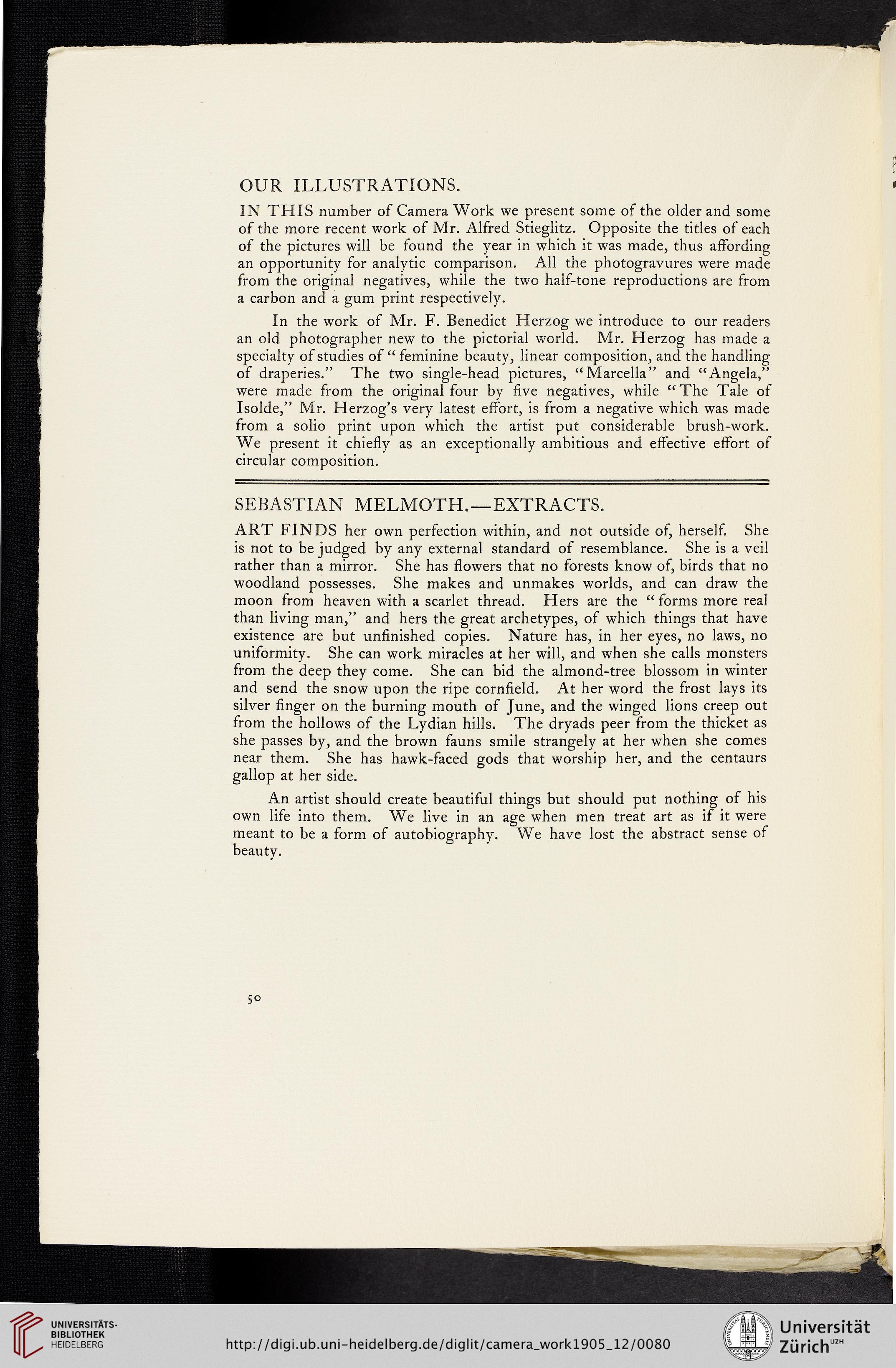Für diese Seite ist auch eine manuell angefertigte Transkription bzw. Edition verfügbar. Bitte wechseln Sie dafür zum Reiter "Transkription" oder "Edition".
OUR ILLUSTRATIONS.
IN THIS number of Camera Work we present some of the older and some
of the more recent work of Mr. Alfred Stieglitz. Opposite the titles of each
of the pictures will be found the year in which it was made, thus affording
an opportunity for analytic comparison. All the photogravures were made
from the original negatives, while the two half-tone reproductions are from
a carbon and a gum print respectively.
In the work of Mr. F. Benedict Herzog we introduce to our readers
an old photographer new to the pictorial world. Mr. Herzog has made a
specialty of studies of “ feminine beauty, linear composition, and the handling
of draperies.” The two single-head pictures, “Marcella” and “Angela,”
were made from the original four by five negatives, while “The Tale of
Isolde,” Mr. Herzog’s very latest effort, is from a negative which was made
from a solio print upon which the artist put considerable brush-work.
We present it chiefly as an exceptionally ambitious and effective effort of
circular composition.
SEBASTIAN MELMOTH.—EXTRACTS.
ART FINDS her own perfection within, and not outside of, herself. She
is not to be judged by any external standard of resemblance. She is a veil
rather than a mirror. She has flowers that no forests know of, birds that no
woodland possesses. She makes and unmakes worlds, and can draw the
moon from heaven with a scarlet thread. Hers are the “ forms more real
than living man,” and hers the great archetypes, of which things that have
existence are but unfinished copies. Nature has, in her eyes, no laws, no
uniformity. She can work miracles at her will, and when she calls monsters
from the deep they come. She can bid the almond-tree blossom in winter
and send the snow upon the ripe cornfield. At her word the frost lays its
silver finger on the burning mouth of June, and the winged lions creep out
from the hollows of the Lydian hills. The dryads peer from the thicket as
she passes by, and the brown fauns smile strangely at her when she comes
near them. She has hawk-faced gods that worship her, and the centaurs
gallop at her side.
An artist should create beautiful things but should put nothing of his
own life into them. We live in an age when men treat art as if it were
meant to be a form of autobiography. We have lost the abstract sense of
beauty.
IN THIS number of Camera Work we present some of the older and some
of the more recent work of Mr. Alfred Stieglitz. Opposite the titles of each
of the pictures will be found the year in which it was made, thus affording
an opportunity for analytic comparison. All the photogravures were made
from the original negatives, while the two half-tone reproductions are from
a carbon and a gum print respectively.
In the work of Mr. F. Benedict Herzog we introduce to our readers
an old photographer new to the pictorial world. Mr. Herzog has made a
specialty of studies of “ feminine beauty, linear composition, and the handling
of draperies.” The two single-head pictures, “Marcella” and “Angela,”
were made from the original four by five negatives, while “The Tale of
Isolde,” Mr. Herzog’s very latest effort, is from a negative which was made
from a solio print upon which the artist put considerable brush-work.
We present it chiefly as an exceptionally ambitious and effective effort of
circular composition.
SEBASTIAN MELMOTH.—EXTRACTS.
ART FINDS her own perfection within, and not outside of, herself. She
is not to be judged by any external standard of resemblance. She is a veil
rather than a mirror. She has flowers that no forests know of, birds that no
woodland possesses. She makes and unmakes worlds, and can draw the
moon from heaven with a scarlet thread. Hers are the “ forms more real
than living man,” and hers the great archetypes, of which things that have
existence are but unfinished copies. Nature has, in her eyes, no laws, no
uniformity. She can work miracles at her will, and when she calls monsters
from the deep they come. She can bid the almond-tree blossom in winter
and send the snow upon the ripe cornfield. At her word the frost lays its
silver finger on the burning mouth of June, and the winged lions creep out
from the hollows of the Lydian hills. The dryads peer from the thicket as
she passes by, and the brown fauns smile strangely at her when she comes
near them. She has hawk-faced gods that worship her, and the centaurs
gallop at her side.
An artist should create beautiful things but should put nothing of his
own life into them. We live in an age when men treat art as if it were
meant to be a form of autobiography. We have lost the abstract sense of
beauty.


